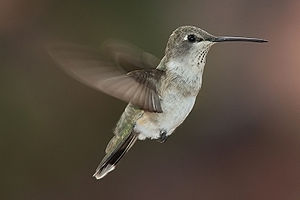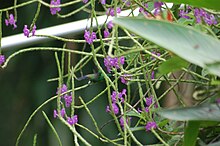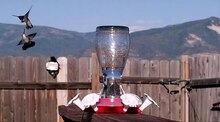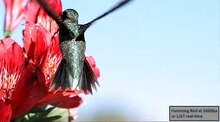Hummingbirds
| Hummingbirds | ||||||||
|---|---|---|---|---|---|---|---|---|

Black-chin hummingbird ( Archilochus alexandri ) |
||||||||
| Systematics | ||||||||
|
||||||||
| Scientific name | ||||||||
| Trochilidae | ||||||||
| Vigors , 1825 |


The hummingbirds (Trochilidae) are birds and, according to almost all authors, represent the only family of the order of the hummingbird-like (Trochiliformes). They are so closely related, however, to both the sailors (Apodidae) and the tree swifts (Hemiprocnidae) that they sometimes with these in the order of the sailing birds (Apodiformes) are summarized.
The hummingbird family comprises more than 100 genera with a total of 368 species . The name Kolibri was borrowed from French in the 18th century (French colibri ) and probably comes from a Caribbean language.
Anatomy and flight ability
anatomy
Among the hummingbirds one can find the smallest bird species ever; the bee elf ( Mellisuga helenae ) measures just 6 cm, including its beak and tail feathers. The giant hummingbird ( Patagona gigas ) is the largest member of the family with a length of approx. 22 cm.
The beaks of the hummingbird species vary widely - often typical of the species - in size and shape. In the sword- billed hummingbird ( Ensifera ensifera ) z. B. the beak is almost as long as the rest of the body, which measures 10 cm. The small- billed hummingbird ( Ramphomicron microrhynchum ) only has a beak length of 5 mm. The beaks of the eagle- billed hummingbirds ( Eutoxeres ) are strongly bent downwards, whereas the beaks of the black-bellied avosette hummingbirds ( Avocettula recurvirostris ) are bent upwards at the tip. Each species of beak is matched to a different type of flower, so that each group of hummingbirds with the same beak occupies its own ecological niche.
The tongue of the hummingbird is extremely long, can be stuck out and is split and straw-shaped at the tip, so that the nectar can be sucked out of the flowers easily.
Hummingbirds have eight pairs of ribs . Usually birds have six pairs of ribs.
In the subfamily Phaethornitinae , the three front toes are attached to each other at the base, in all other hummingbirds (formerly combined to the subfamily Trochilinae ) the front toes are free.
plumage

Most hummingbirds have brightly colored, shimmering plumage . The head, throat and chest are preferably provided with iridescent colors. The throat of the males is usually brightly colored, with exceptions here, for example the eagle-billed hummingbird . The effect of the play of colors comes about through interference . The iridescent hummingbird feather has several layers of microscopic horn lamellae. If light hits this spring from a certain angle of incidence, it is reflected back by the lamellae. Due to the different position of the slats, the light is reflected in very small time differences. The observer perceives the color of the plumage differently from different perspectives (see photos of the ruby hummingbird below).
In the subfamily Phaethornitinae, the control feathers are greatly elongated.

The flight of the hummingbirds
Hummingbirds fly at a very high frequency of 40 to 50 wing beats per second. With their flexible wings they can fly on the spot, for example to drink nectar. You can also fly sideways and even backwards. This makes the hummingbird the only bird in the world that has this ability. In the hummingbird, in contrast to all other bird families, the hand is larger than the upper arm and forearm. This as well as extreme mobility in the shoulder and elbow joints allow the hummingbird to have almost any conceivable wing position. The chest and upper arm muscles required for this make up a quarter of its total weight in the hummingbird.
In terms of body size, hummingbirds are arguably the fastest vertebrates in the world. Anna's hummingbirds, about ten centimeters in size, reach speeds of 385 body lengths per second (27.3 m / s or 98 km / h) during their courtship flights , with acceleration values about ten times the acceleration of gravity . For comparison: Peregrine falcons swoop at speeds of up to 200 body lengths per second, fighter jets such as B. the MiG-25 (a Mach 3 faster interceptor), on the other hand, only reach a maximum of around 40 times their total length.
physiology
The heart of the hummingbird is very large in relation to its body and beats 400 to 500 times per minute, their breathing rate is up to 250 strokes per minute. During sleep, many hummingbirds lower their heart rate sharply to save energy.
Since the entrance and exit of the hummingbird's stomach are very close to each other, the liquid food ingested is transferred from the entrance to the exit when the stomach is full. This means that the flower nectar does not first reach the small intestine via the gizzard , but can reach it directly, where it is split up and fed into the energy metabolism .
The oxygen consumption of the hummingbirds reaches a very high value and is five to ten times higher than that of finch birds, even in resting animals .

Hummingbirds have developed the ability to lower their body temperature significantly in order to reduce their metabolism in emergency situations so that they can survive. In hummingbirds, a state of complete indifference ( torpidity ) has also been described.
distribution and habitat
Hummingbirds only live in South America , North America, and the Caribbean . They occur from southern Alaska to Tierra del Fuego . They live in semi-deserts, in the forest areas on the Amazon and in temperate zones in the deciduous forests of Chile. They are found almost everywhere in southern North and South America, except in the subantarctic and boreal zones. Of the 330–340 species, almost 130 live near the equator . Only a good dozen species live in North America north of Mexico , most of them in the southwestern United States . The ruby- throated hummingbird ( Archilochus colubris ) is the only one to breed in eastern Canada and the USA. The pennant tail ( Trochilus polytmus ), the male of which has a tail up to 17 cm long, lives only in Jamaica .
The pigeon tail ( Macroglossum stellatarum ) is a butterfly that lives in Europe and Asia. Standing in the air, it sucks nectar into flowers with its proboscis and is therefore sometimes mistaken for a hummingbird.
nutrition
The hummingbirds feed mainly on flower nectar . This very energy-rich food makes the power-sapping flight style possible. The hummingbirds are particularly attracted to flowers with striking red or orange colors. More than 7000 hummingbird- pollinated plant species in 404 genera and 68 families are known.
In addition to nectar, hummingbirds also eat small amounts of insects and spiders to ensure a sufficient supply of protein . Pollen and pulp are completely indigestible for hummingbirds and are therefore not ingested.
Coevolution with forage plants
The oldest representatives of hummingbirds and their forage plants in a geographical region, such as North America or the Caribbean, are of the same age in evolutionary terms. After colonizing one of these regions, the hummingbird lines were diversified and / or other lines were colonized. It is similar with the hummingbird-pollinated plant groups. Here, too, new species emerged and / or hummingbird-pollinated species emerged in other groups of plants that had not yet been pollinated.
Most species of hummingbird feed on the nectar of a variety of plant species. Only a few species with a highly specialized beak shape - such as the sword- billed hummingbird or the sickle- billed hummingbird - eat the nectar of a smaller, but exclusive group of plants that are not accessible to other hummingbird species due to their flower morphology. Due to the extreme shape of the beak and flower, it was long assumed that these species would co-evolve with their hummingbirds. However, the latest research has shown that extreme dependencies of a hummingbird species on a group of plant species can also have arisen in the course of the evolution of this hummingbird species and that the plant species involved are accordingly younger than the pollinating hummingbird species.
Reproduction

In order to arouse interest in the females and make them ready to mate, the males perform a courtship dance . After mating, the females build a tiny nest made of cobwebs , plant wool , lichen or moss . The nest is hidden in a bush or tree at a low height. The female lays two eggs two days apart . The brood lasts 14 to 19 days. The young are then fed up to 140 times a day for 3–4 weeks. To search for food, the females drop out of the nest and slide to the ground like a leaf. This makes it much more difficult for nest robbers to locate the hidden nest.
Enemies
Natural enemies of the hummingbirds are snakes , birds of prey , cats and martens .
Fossils
The German paleo-ornithologist Gerald Mayr from the Senckenberg Research Institute in Frankfurt discovered what are probably the oldest hummingbird fossils in the world in the Unterfeld mine in Frauenweiler in Baden-Württemberg (district of Wiesloch ). In the journal Science he describes the discovery of two fossils over 30 million years old that resembled the American hummingbirds living today. They are the first hummingbirds found in the Old World.
The skeletons are about four centimeters long, have a long beak to suck up flower nectar, and wings that enable them to float in place. They show the typical characteristics of today's hummingbirds.
Mayr baptized it with the name Eurotrochilus inexpectatus - "unexpected, European hummingbird".
Keeping as an ornamental bird
Hummingbirds are considered difficult to keep pet birds. One of the few species that are also kept by private individuals is the violet-eared hummingbird , which has already been bred.
Systematics
literature
- Dieter Poley: Hummingbirds: Trochilidae. (= Die Neue Brehm-Bücherei. Volume 484). 3. Edition. Westarp Sciences, 1994, ISBN 3-89432-409-0 .
- Helmut Folger: Hummingbirds: Their way of life and attitude . Eugen Ulmer, Stuttgart 1982, ISBN 3-8001-7073-6 .
- Scott Weidensaul: Hummingbirds: Flying Diamonds . Karl Müller, Erlangen 1990, DNB 910530017 .
Web links
- The Hummingbird Society - a non-profit organization dedicated to protecting hummingbirds
- Flight of the hummingbird: between bird and insect. On: Wissenschaft.de from June 25, 2005
- Animation and description of the flapping of the wings of hummingbirds On: uni-frankfurt.de
- Photographs of hummingbirds in flight. On: macro-photo.org
Individual evidence
- ^ BirdLife International: Hummingbirds. Retrieved December 25, 2019 .
- ↑ Duden Volume 7 - Dictionary of Origin - Etymology of the German Language. 3. Edition. Dudenverlag, Mannheim / Leipzig / Vienna / Zurich 2001, ISBN 3-411-04073-4 .
- ↑ Christopher James Clark: Courtship dives of Anna's hummingbird offer insights into flight performance limits. In: Proceedings of the Royal Society: B. Volume 276, No. 1670, 2009, doi: 10.1098 / rspb.2009.0508 (freely accessible online publication)
- ↑ Abrahamczyk, S. & Kessler, M .: Morphological and behavioral adaptations to feed on nectar: how feeding ecology determines the diversity and composition of hummingbird assemblages . Ed .: Journal of Ornithology. tape 156 , 2015, p. 333-347 .
- ^ Abrahamczyk, Stefan & Renner, Susanne S .: The temporal build-up of hummingbird / plant mutualisms in North America and temperate South America . Ed .: BMC Evolutionary Biology. tape 15 , 2015, p. 104 .
- ↑ Abrahamczyk, S., Souto-Vilarós, D., McGuire, J., Renner, SS: Diversity and clade ages of West Indian hummingbirds and the largest plant clades dependent on them: a 5-9 Myr young mutualistic system . Ed .: Biological Journal of the Linnean Society. tape 114 , 2015, p. 848-859 .
- ↑ Abrahamczyk, S., Souto-Vilarós, D., Renner, SS: Escape from extreme specialization: passionflowers, bats and the sword-billed hummingbird . Ed .: Proceedings of the Royal Society B. Band 281 , 2014, p. 20140888 .
- ↑ Abrahamczyk, S., Poretschkin, C. Renner, SS: Evolutionary flexibility in five hummingbird / plant mutualistic systems: testing temporal and geographic matching . Ed .: Journal of Biogeography. tape 44 , 2017, p. 1847-1855 .
- ↑ Gerald Mayr: Old World Fossil Record of Modern-Type Hummingbirds. In: Science . Volume 304, 2004, pp. 861-864, doi: 10.1126 / science.1096856




